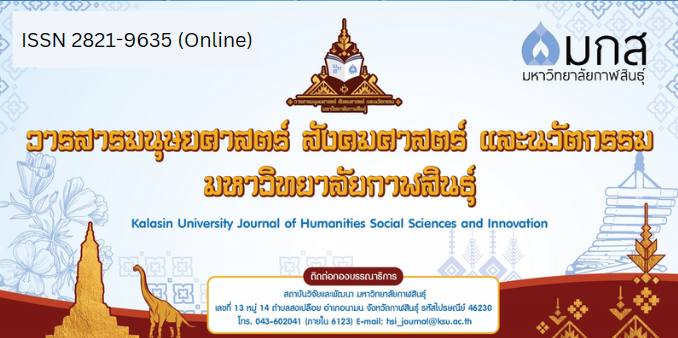ปัจจัยที่มีอิทธิพลต่อพฤติกรรมการท่องเที่ยวหลังสถานการณ์โควิด 19
Main Article Content
บทคัดย่อ
ปัจจุบัน โรคโควิด-19 ได้รับการประกาศให้เป็นโรคประจำถิ่น ประชาชนส่วนใหญ่ได้รับวัคซีนและมีสุขภาพที่ดีขึ้น หน่วยงานต่าง ๆ จึงผ่อนคลายมาตรการควบคุมวิถีชีวิตประจำวัน อย่างไรก็ตาม ความปลอดภัยและสุขอนามัยยังคงเป็นประเด็นที่ต้องให้ความสำคัญอย่างต่อเนื่อง โดยเฉพาะในกลุ่มผู้มีโรคประจำตัว เมื่อสถานการณ์การระบาดผ่านพ้นไป ภาคส่วนต่าง ๆ โดยเฉพาะภาคธุรกิจ ต่างเร่งฟื้นฟูกิจการ รวมถึงภาคธุรกิจการท่องเที่ยวที่ได้รับผลกระทบอย่างรุนแรง งานวิจัยนี้มีวัตถุประสงค์เพื่อวิเคราะห์ปัจจัยที่มีอิทธิพลต่อพฤติกรรมการท่องเที่ยวหลังสถานการณ์โควิด-19 และเพื่อทดสอบความสอดคล้องกลมกลืนของโมเดลกับข้อมูลเชิงประจักษ์ กลุ่มตัวอย่างที่ใช้ในการวิจัย คือ นักท่องเที่ยวจำนวน 514 คน ซึ่งเป็นประชาชนในจังหวัดกาฬสินธุ์และจังหวัดอื่นที่เดินทางมาเยือน โดยใช้แบบสอบถามแบบตอบด้วยตนเอง และวิเคราะห์ข้อมูลด้วยสมการโครงสร้าง (Structural Equation Modeling: SEM) ผลการศึกษาพบว่า การแพร่ระบาดของโควิด-19 มีอิทธิพลต่อพฤติกรรมการท่องเที่ยวหลังสถานการณ์โควิด-19 อย่างมีนัยสำคัญ แม้ว่าในขั้นต้นโมเดลจะไม่สอดคล้องกับข้อมูลเชิงประจักษ์ตามสมมติฐานที่ตั้งไว้ แต่เมื่อมีการปรับโมเดลให้เหมาะสมกับบริบทของจังหวัดกาฬสินธุ์ พบว่า การแพร่ระบาดของโควิด-19 มีอิทธิพลอย่างมีนัยสำคัญทางสถิติที่ระดับ 0.01 ต่อปัจจัยด้านการบริหารจัดการความเสี่ยง การให้บริการ และสุขอนามัยและความปลอดภัย ประโยชน์ที่ได้จากงานวิจัยสามารถนำไปใช้ในการเผยแพร่ความรู้แก่ประชาชนและนักท่องเที่ยวในด้านการบริหารความเสี่ยง และการวางแผนการเดินทาง โดยเฉพาะการคำนึงถึงสุขอนามัย ความสะอาด และความปลอดภัยของสถานที่ท่องเที่ยว เพื่อป้องกันการแพร่ระบาดของโรคติดต่อในอนาคต
Downloads
Article Details

อนุญาตภายใต้เงื่อนไข Creative Commons Attribution-NonCommercial-NoDerivatives 4.0 International License.
ข้อมูลภาพ เสียง วิดีโอ และข้อความที่ปรากฎบนเว็บไซต์นี้ ผู้นำไปใช้จะถูกอนุญาตให้นำไปใช้ได้ โดยจะต้องอ้างอิงแหล่งที่มา จะต้องไม่นำไปใช้เพื่อการค้า และจะต้องไม่ดัดแปลง (CC-BY-NC-ND)
เอกสารอ้างอิง
กระทรวงการท่องเที่ยวและกีฬา. (2564). กองเศรษฐกิจการท่องเที่ยวและกีฬา.
กระทรวงสาธารณสุข. (2567). สถานการณ์ผู้ป่วย COVID-19 รายวัน. กระทรวงสาธารณสุข. Retrieved 6/05 from https://ddc.moph.go.th/covid19-dashboard/?dashboard=main
กรุงเทพธุรกิจออนไลน์. (2565). สิ่งที่จะเปลี่ยนแปลง เมื่อ "โควิด-๑๙" เป็น "โรคประจำถิ่น". กรุงเทพธุรกิจออนไลน์. Retrieved 6/05 from https://www.bangkokbiznews.com/social/986659
ChartExpo. (2025). 7-Point Likert Scale: Step by Step Guide. Microsoft Excel. https://chartexpo.com/blog/7-point-likert-scale#why-us-7-point-likert-scale
Daire Hooper, J. C., Michael Mullen. (2008). Structural Equation Modelling: Guidelines for Determining Model Fit Electronic Journal of Business Research Methods, 53-61.
Dedeoğlu, B. B. (2019). Shaping tourists' destination quality perception and loyalty through destination country image: The importance of involvement and perceived value. Tourism Management Perspectives, 29, 105-117. https://doi.org/https://doi.org/10.1016/j.tmp.2018.11.006
Fornell, C., & Larcker, D. F. (1981). Evaluating Structural Equation Models with Unobservable Variables and Measurement Error. Journal of Marketing Research, 18(1), 39-50. https://doi.org/10.2307/3151312
Golob, T. F. (2003). Structural equation modeling for travel behavior research. Transportation Research Part B: Methodological, 37(1), 1-25. https://doi.org/https://doi.org/10.1016/S0191-2615(01)00046-7
Hair, J. F. B., W.C. Babin, B.J. (2010). Multivariate Data Analysis: A Global Perspective. Pearson Education. https://books.google.co.th/books?id=SLRPLgAACAAJ
Han, H., & Hyun, S. S. (2015). Customer retention in the medical tourism industry: Impact of quality, satisfaction, trust, and price reasonableness. Tourism Management, 46, 20-29. https://doi.org/https://doi.org/10.1016/j.tourman.2014.06.003
Hu, L. t., & Bentler, P. M. (1999). Cutoff criteria for fit indexes in covariance structure analysis: Conventional criteria versus new alternatives. Structural Equation Modeling: A Multidisciplinary Journal, 6(1), 1-55. https://doi.org/10.1080/10705519909540118
Jomnonkwao, S., Sangphong, O., Khampirat, B., Siridhara, S., & Ratanavaraha, V. (2016). Public transport promotion policy on campus: evidence from Suranaree University in Thailand. Public Transport, 8(2), 185-203. https://doi.org/10.1007/s12469-016-0122-2
Kline, R. B. (2011). principles and practice of structural equation modeling. Guilford Press.
Loehlin, J. C. (1998). Latent variable models: An introduction to factor, path, and structural analysis, 3rd ed. Lawrence Erlbaum Associates Publishers.
Moon, H., & Han, H. (2018). Destination attributes influencing Chinese travelers' perceptions of experience quality and intentions for island tourism: A case of Jeju Island. Tourism Management Perspectives, 28, 71-82. https://doi.org/https://doi.org/10.1016/j.tmp.2018.08.002
Rahman, M. K., Gazi, M. A. I., Bhuiyan, M. A., & Rahaman, M. A. (2021). Effect of Covid-19 pandemic on tourist travel risk and management perceptions. PloS one, 16(9), e0256486. https://doi.org/10.1371/journal.pone.0256486
Steiger, J. H. (2007). Understanding the limitations of global fit assessment in structural equation modeling. Personality and Individual Differences, 42(5), 893-898. https://doi.org/https://doi.org/10.1016/j.paid.2006.09.017
Stylidis, D., Shani, A., & Belhassen, Y. (2017). Testing an integrated destination image model across residents and tourists. Tourism Management, 58, 184-195. https://doi.org/https://doi.org/10.1016/j.tourman.2016.10.014
Thailand, W. H. O. (2567). สถานการณ์โรคติดเชื้อไวรัสโคโรนา 2019 ในประเทศไทย. Retrieved 3/05 from https://www.who.int/thailand/news/detail/07-02-2024-update-on-covid-19-in-thailand--7-february-2024-THA
Ursachi, G., Horodnic, I. A., & Zait, A. (2015). How Reliable are Measurement Scales? External Factors with Indirect Influence on Reliability Estimators. Procedia Economics and Finance, 20, 679-686. https://doi.org/https://doi.org/10.1016/S2212-5671(15)00123-9


